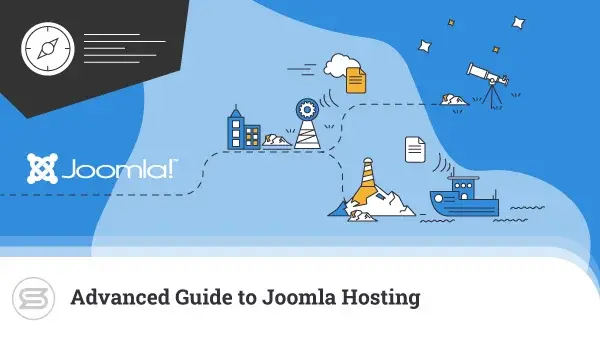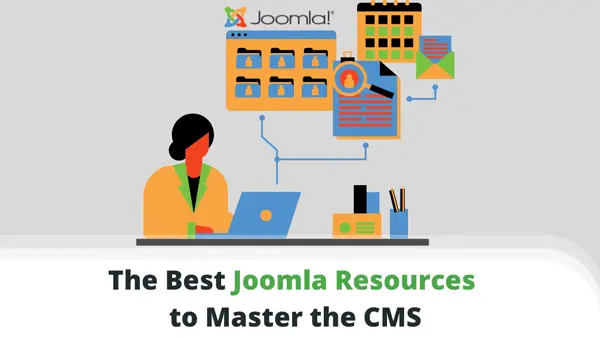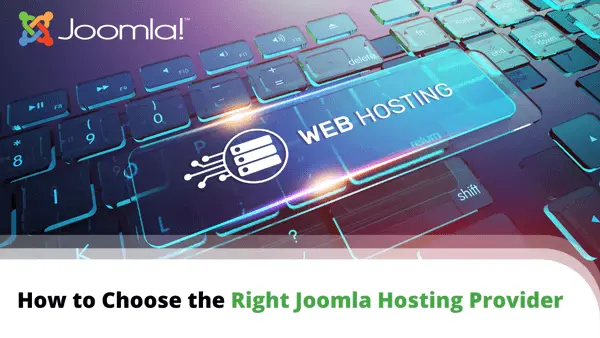The fact that you’re considering working on your very own online project means that you already have an idea of what you want to build. Many platforms and apps can help you turn it into reality, but figuring out where to begin isn’t always as obvious as you may think.
Joomla is one such app. It’s not quite as popular as WordPress, but it nevertheless has a considerable and highly loyal fan base. There are plenty of reasons to join the millions of people who use it, and today, we’ll show you how to do that.
First, though, a short introduction.

What is Joomla?
One of the first things you usually do when researching a new software application is turn to Google, and if you do, you’ll see that Joomla is an open-source Content Management System (CMS) that is written in PHP and uses a MySQL database to store information.
Straightaway, we can see how some of the less tech-savvy among you will struggle to keep up with the terminology, so let’s explain it in layman’s terms.
Joomla is a website-building application you install on a suitable server or hosting account. When it’s up and running, you get access to a backend dashboard (commonly referred to as the Administrator or Admin area) where you upload and manage content, tweak the website’s functionality, change its appearance, and optimize the security and performance.
Being open-source means its source code is freely available and can be modified and redistributed. In other words, you can download and use it as much as you want without paying a penny.
The websites you create with Joomla are dynamic, meaning they’re much more than a collection of HTML code and media files rendered on the user’s screen. Instead, in addition to the content you upload, you also have data generated by the app and submitted by users. All of it is stored in a database, and Joomla can retrieve it whenever needed.
This enables you to create a more complex and functional website, and it’s part of the reason why Joomla is suitable for such a broad range of projects. You can use it for anything from a personal blog to a fully-fledged ecommerce site that processes payments and has all the functionality of the world’s top online retailers.
Because Joomla’s backend has a graphic user interface, you can do all this without writing thousands of lines of code.
But is it really that simple?

How Does Joomla Compare to Other CMS Solutions?
If you continue your Google research, you’ll probably stumble upon the opinion that Joomla is relatively complex to work with. Part of this misconception comes from the fact that people usually compare Joomla to WordPress.
WordPress is the world’s most popular website building-application, powering over 40% of the websites we visit every day. It’s certainly easy to get used to, especially if you’re a complete novice.
Joomla may present a slightly steeper learning curve, but this doesn’t mean that you need a computer science degree to make the most of it.
The WP dashboard does seem more straightforward, but that’s because WordPress was originally designed as a blogging platform. Even though people now use it for other projects, its default settings and features are still centered around the management of blog posts and pages.
By contrast, Joomla was spawned as a fork of the Mambo CMS, and it was conceived from the start as a full-on content management system. It has many more features out of the box, so it’s only natural that you have more menus to look at and play with.
Over the years, Joomla’s developers have done a lot to make the admin area more intuitive, with one of the most significant leaps in that direction visible in Joomla 4.
The latest major release also introduced a number of other improvements, including security, performance, search engine optimization features, better search functionality, and many more.
The idea behind all these upgrades is to keep Joomla competitive, and it shows that considering it while choosing a platform for your new website is definitely worthwhile. Here’s what you’ll have to do if you decide to go with it.

Building a Website With Joomla
You don’t need special technical skills or experience to start a new Joomla website. However, if you don’t know what you need to do or how to do it, the whole process could turn into a bit of a nightmare.
Here’s how to approach the matter in order to avoid any potential headaches.
1. Get a hosting service
Your website won’t work without hosting. The cheapest and easiest option would be to use Joomla Launch – a free service offered by Open Source Matters, Inc., the company maintaining Joomla. After you sign up for free, you get an account with the latest supported version of Joomla 3 or Joomla 4 installed on it, and you can start work on your site immediately.
However, if you’re serious about your project, this service is unlikely to sustain you in the long run.
The Joomla installation you get with it is fully featured, and you can install add-ons, but the free plan offers just 500MB of storage space, and you’re forced to use a joomla.com subdomain (i.e., your site will be accessible through a URL that looks like this: http://yoursite.joomla.com/).
If you opt for a premium plan, you can use your own domain, and you’ll get other goodies like customer support, an SSL certificate, and daily offsite backups. Even so, services offered by proper hosting companies should give you many more features and easier scalability that could be crucial in the future.
Finding a service that supports Joomla won’t be a problem. The CMS works with the so-called LAMP stack – a web hosting setup that includes the Linux operating system, the Apache web server, the MySQL database management system, and the PHP programming language. It’s a common setup used by pretty much all hosts on the market.
The tricky part is finding a solution that will give you not only the performance you’re after but also the tools to easily launch and manage your project.


You can often start with a cheap shared account. Most of the plans at that end of the scale support Joomla, and they cost as little as a few dollars per month. You have to bear in mind, however, that shared hosting could present problems as soon as your site starts growing.
A shared account can’t provide you with adequate performance and security if your website is attracting any sort of serious interest, so sooner or later, you will need to upgrade to a more powerful Virtual Private Server (VPS). You need to choose between a managed and a self-managed VPS.
Experienced website administrators who have the time to do everything on their own can opt for a self-managed solution. With it, they’ll have the freedom to configure every component that supports their website to their own specifications. It’s perfect for people who need a custom hosting environment and know how to create one. For everyone else, a managed server is probably the better option.
With it, the hosting provider’s specialists set up and configure the VPS for the best possible performance and security. You get the machine ready to go, so you can start work on your project immediately.
Your host will also maintain the server’s critical components in perfect working order. You don’t need to worry about installing OS updates or configuring the machine to use the latest technologies – your provider will take care of all of this.
2. Install Joomla
Setting up Joomla on your hosting account consists of three main steps – copying the CMS files in your site’s document root folder, creating a database, and configuring the application to work with the database.
There are a few methods to choose from:
- Manually – You can get the zip file with the CMS from https://joomla.org and use an FTP client or a File Manager to upload and unzip it in your site’s document root folder. Then, you’ll use your control panel to create the database and, finally, connect the Joomla to it via the initial setup wizard.
- Via the command-line interface – If you’re comfortable working with the console, you can also use commands to download and extract the Joomla files in your document root directory and set up the database.
- Through an auto-installer – This is the option most people would likely prefer. Most control panels that are pre-installed on managed shared and VPS accounts usually include an automatic installer that sets up popular CMS solutions like Joomla with no more than a couple of clicks. In some cases, you may even find tools with additional Joomla-specific options.
During the installation process, you get to pick the login credentials you’ll use to access the site’s admin area. Don’t underestimate the importance of this task. If hackers can guess them, they could take over the entire website, so be sure to choose a strong password.
3. Customize the appearance of your Joomla website.
Although it goes against the old saying, in the online world, books (or, more precisely, websites) are judged by their covers.
You need a design that leaves visitors with a good impression, which is more complicated than it may appear at first. On the one hand, your site should have a memorable appearance that users can easily recognize and associate with your brand. On the other, the page layout and menus must make the experience as smooth as possible.
With a custom website, the design would need to be built from scratch. However, because you’re using Joomla, you can base it on a ready-made template.
A Joomla template is a collection of files that modify your website’s appearance. There are thousands of different templates created for all sorts of websites, so whether you’re building a business website, a news outlet, or an online store, you’ll likely find a design that fits your needs.
Take the time to pick the right one, though. Choosing the correct template is a critical step in building a successful Joomla website, and it’s crucial not to underestimate its importance.
First, narrow your choice to the templates compatible with your website. Joomla 4, the CMS’s latest major release, came with some serious changes to the underlying architecture, meaning more than a year later, some add-ons still aren’t compatible with it. Similarly, newer templates and plugins may not work with Joomla 3, which, at the time of writing, is still supported.
Next, sift through the options and shortlist the ones designed for the type of website you’re building. There’s no point in considering ecommerce templates if you’re building a news website.
Don’t forget the budget. Some templates are supported by the community and are completely free. However, many are commercial products created by teams of professional developers.
Prices tend to vary wildly, so have a good look around and see which templates will fit within your financial limitations. This is important because if you spend too much on a template, you won’t have enough resources to build other aspects of your online business.
The price isn’t the most important factor, though. You also have to ensure your site’s design leaves a long-lasting impression.
To do that, you have to find a template with enough personalization options to create a look that is unique to your brand. All templates let you customize the default design to some extent, but make sure the one you choose gives you enough freedom to create a website that is both good-looking and original.
4. Extending your Joomla site’s functionality.
We’ve already established that Joomla is more versatile than many of its competitors. However, this doesn’t mean it can support any functionality that comes to your mind.
Like most CMS applications, a worldwide community of developers, fans, and superusers work on various solutions that expand Joomla site’s arsenal of features. With other CMS solutions, these solutions are all categorized under a single term. For example, WordPress users call them plugins, while the Drupal community refers to them as modules.
The Joomla ecosystem is a bit more complicated. All add-ons fall under the category “extensions,” but depending on how they work, they are also divided into the following groups:
- Components – Joomla describes components as mini-applications. They usually have a front end and a back end, and they are responsible for rendering most of the elements users see on their screens.
- Modules – Modules may be responsible for the smaller graphical elements on the page, but they can be crucial for the site’s functionality. For example, a module can be the box that lets users sign up for a newsletter, log in to their profile, or see who’s online.
- Plugins – Plugins are described as event handlers. They have a wide range of applications and can be implemented in various ways to modify your website’s behavior. For example, if you allow user-submitted comments and articles, you can use a plugin to filter bad words and inappropriate content.
Templates and language packs are also classified as extensions, though they’re not strictly connected to the website’s functionality.
At the time of writing, the official Joomla repository holds just under 6 thousand extensions, and you can find many more on third-party websites. Because Joomla is such a popular open-source platform, you can easily find a developer who can create custom extensions specifically for your project, as well.
That being said, you have such a broad choice of add-ons you’re unlikely to find yourself in a situation where there will be no extension that fits your requirement. Add-ons are an important part of any Joomla project.
However, make sure you don’t get carried away. Only add extensions that can really bring value. There’s no point in having features that nobody uses.
What’s more, too many Joomla extensions can affect the performance, so be sure to avoid installing add-ons you don’t need.
5. Adding content to your Joomla website
With the appearance and functionality sorted, it’s time for the easiest part of setting up a Joomla website – adding content.
Although WordPress is hailed as the more user-friendly CMS, many website administrators argue that the (now not so) new block editor is decidedly trickier to get used to than what Joomla has to offer.
Joomla’s default content editor is called TinyMCE, and finding your way around it shouldn’t be a problem, even for those who have never worked in a website’s backend. It has all the options to write and format text and add the required media. Crucially, they’re exactly where you’d expect them to be.
To publish the first article on your Joomla website, log in to the Admin area, go to Content > Articles, and click the New button. You’ll see the fields for your article’s title, the alias that will be a part of the URL, and the main box where you can paste your content. In the expandable ribbon above it, you’ll find the buttons and menus for formatting the text, adding images, etc.
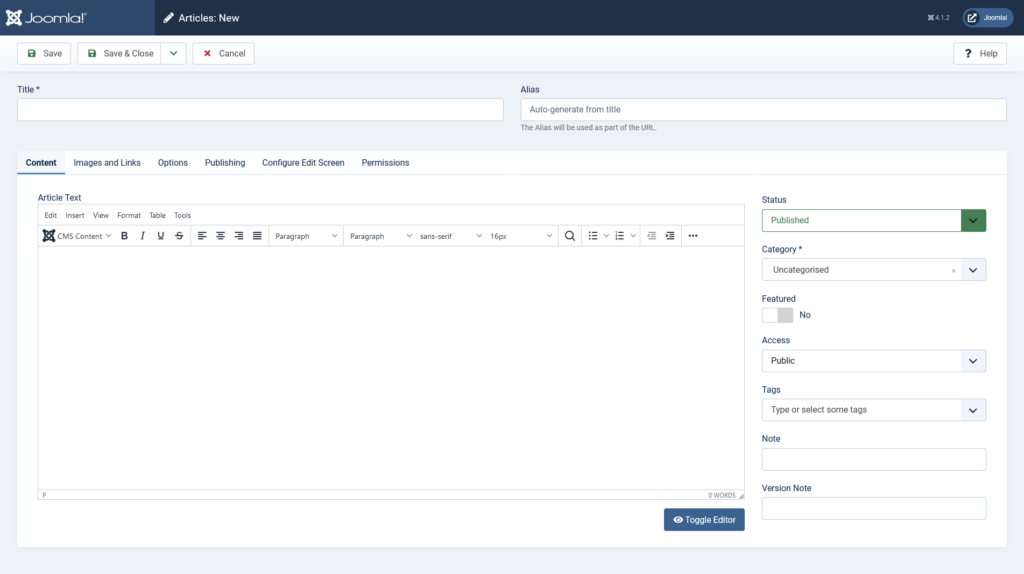
TinyMCE is what’s known as a WYSIWYG (What You See Is What You Get) editor, so you don’t need to write or edit HTML code to publish or format your articles. If you’ve worked with popular word processing applications like Microsoft Word, you should have no problems getting used to it.
Best of all, if you don’t like TinyMCE, you can replace it with a third-party extension that offers the same functionality.
The menus and buttons to the right of the main content editing screen help you do a range of different things, including adding images, categorizing your article, modifying the way it looks, setting a publishing schedule, etc.
Managing files is another critical aspect of uploading content to a website, and for years, Joomla was lagging behind its competition in this particular aspect. The default media manager in Joomla 3 and earlier lacked some crucial features, and many users preferred to look for third-party alternatives.
This was noticed by Joomla’s developers, and with Joomla 4, they introduced a completely overhauled media manager. Files can now be uploaded via a simple drag-and-drop, and there are a few extra image editing tools. The entire interface is much more intuitive, and it shows the development team’s commitment to creating a CMS that is more functional and easier to get used to.
6. Managing and maintaining your Joomla website
By this stage, you should have a fully-functioning Joomla website with a unique design, the functionality you’re after, and some content. With the right strategy, you should be able to start attracting visitors soon.
However, this will be far from enough to sustain your project in the long run.
Users need to remain interested, which means keeping the site fresh and in perfect working order. This may be harder than it seems at first.
Here are a few things you should consider:
- Content: First, you have to make sure visitors keep coming back. The best way to do it is to provide them with the quality content they expect. Many site owners think that content only helps with SEO, and they often create websites best suited for Google bots, not humans.
Keywords are essential, but you’re unlikely to impress users if your writing is too SEO-centric.
Keep a close eye on how people interact with your website and try to give them what they want. Based on your findings, devise a content strategy that turns accidental visitors into return customers.
- Performance: Nobody likes a slow website, so keep an eye on your loading speeds and make sure they’re always up to par. If they aren’t, you need to tackle the issue urgently.
More often than not, the problem lies either with an extension (or extensions) hogging hardware resources or an inadequate hosting package. When you address the speed issues, you can consider a few things that could further boost your site’s performance.
- New features: You can’t afford to sit still. Users must see that the website is under active development, meaning regular updates, new features, and revamps of old ones. The Joomla community is working non-stop, releasing new and exciting functions that can transform your site’s user experience. Keep up with the trends and see which of these new additions align with your project.
- Security: A single security incident can spell the end of the entire project. As a website owner, you’re responsible for keeping your users’ data safe, and if you don’t, visitors will be rightfully unhappy with you.
First, take a look at the security mechanisms provided by your host. If you’re on a managed plan, many of them (like the server’s firewall, for example) will require no configuration on your end. However, others, like two-factor authentication (2FA) for your control panel or client area, need to be enabled by you.
Speaking of which, Joomla also gives you plenty of security features by default, and there are quite a few extensions that can help you protect your site. Make sure you check them out.
Last but by no means least, you have to keep your software updated. Always install the latest versions of the Joomla core, the extensions, and the templates you use as soon as they come out. They include the newest security patches and prevent hackers from exploiting known vulnerabilities.
ScalaHosting and Joomla
Many hosts can support your Joomla website. However, few providers offer a range of Joomla-specific features as rich as that found at ScalaHosting.
First, you have a wide choice of hosting plans, all suitable for launching a successful Joomla-powered project. You can start small with an affordable shared hosting option. Your account will be deployed in seconds, and you’ll have access to the cPanel management platform equipped with Softaculous – a one-click installer that can automatically set up Joomla on your account and let you start work on your project immediately.
As your website grows, you’ll have plenty of options for upgrading to a much more powerful virtual private server. All you’ll need to do is pick the hardware configuration and the location. It’s our job to deploy the server, and we can even migrate your website for you at no cost and with no downtime.
Alternatively, you can go straight for our VPS solutions. This way, you’ll have guaranteed resources, a dedicated IP, and all the performance and security benefits that come with them from the start. With a VPS, you can control your hosting account via SPanel – a proprietary management platform built by ScalaHosting and designed explicitly for VPS hosting.
Once again, you get an intuitive graphical user interface for managing all aspects of the projects hosted on your server. There is an extra treat for Joomla users.
The dedicated Joomla Manager is available in SPanel’s User Interface.

First, you can use it to install Joomla on your account. The interface is about as simple as it gets. You pick the domain and the installation folder, choose the admin login credentials, and set an admin email address. A couple of seconds after you click the Install Joomla button, the CMS will be set up and ready to go.
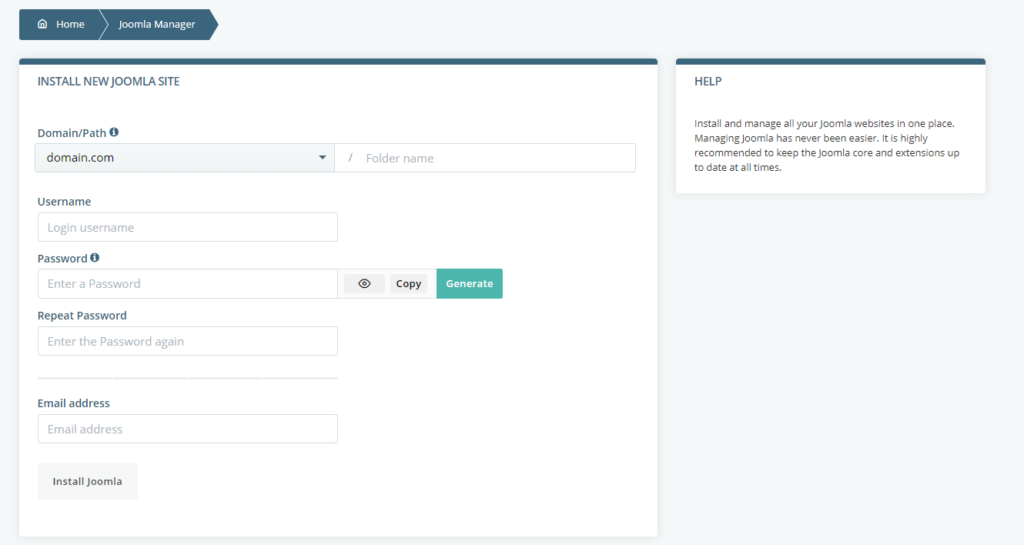
At the bottom of the page, you have a list of all active Joomla installations on the account. You can run as many projects as you want on your account. From the same menu, you can reset the admin password for each website and delete the ones you no longer need.
The Clone option in the Actions menu is particularly useful if you want to stick to the best web development practices. With it, you can create an exact copy of your main website, along with all its content, extensions, templates, etc., and put it in a subfolder. You can then use that copy as a staging environment. The idea is to test various new features and ensure they work fine before implementing them on the live website.

Couple all this with servers that are optimized to provide the best possible performance and security, and you’ll see that you have an excellent environment for building a Joomla website.
But don’t just take our word for it. Check out the video below to see why Brian Teeman, one of Joomla’s co-founders, decided to move all his websites to ScalaHosting.
Brian Teeman – SCALA HOSTING – Long Version
Conclusion
Launching a new website is always an exciting journey. However, as with everything, it can quickly turn rather frustrating if you don’t have a clear idea of what you need to do and when you need to do it.
Fortunately, if you use Joomla, you have a lot of resources you can lean on that automate some of the tasks, eliminate the need to complete others, and help you with the overall process. All you need to do is learn how to make the most of these resources.
FAQ
How do I start using Joomla?
All you need to start work on your new Joomla website is a suitable hosting account where you install the CMS and start work on the project. Almost all hosting solutions out there support Joomla, and often, you have an auto-installer that sets up the application for you.
Is Joomla free?
Joomla is an open-source project meaning the source code can be freely downloaded and redistributed. You can use it for as many websites as you want without paying any licensing fees.
How do I host a Joomla website?
The technologies powering Joomla are well-known to most hosting providers. You need a service that supports PHP and MySQL or PostgreSQL databases and runs on Apache, Nginx, Microsoft IIS, or LiteSpeed/OpenLiteSpeed. This is a standard setup, and most hosting providers support it in one form or another.

